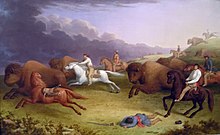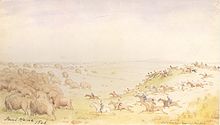Métis in Canada
The Métis (pronounced [meˈtis], French for mestizo) are an ethnic group in Canada and parts of the United States, such as North Dakota and Montana. They are descendants of European fur traders-particularly from France, England, and Scotland-and women of Native American descent. At one time, there were major cultural, linguistic as well as religious differences between French-born Métis and English- and Gaelic-born Métis.
The Métis francophones, who make up the largest group, are descendants of francophone traders and trappers as well as women, especially of the Cree, Anishinabe, Saulteaux, Nakota, Ojibwa, Abenaki, Menominee, Mi'kmaq or Maliseet ethnic groups. After the defeat of France in the French-Indian War, the latter had to cede Canada to the British in the Peace of Paris in 1763 - and thus could no longer protect the French settlers as well as their Indian allies and the Metis communities. Therefore, many French-born Métis as well as French traders, trappers and settlers moved further west into the Rocky Mountains as well as northwest into the woods - where they married Chipewyan, Woodland Cree, Dogrib, Yellowknife, Slavey, Gwich'in and Inuvialuit women. Through this connection they developed their own language, the Michif (also Cris français, Mitchif), which is based on the so-called métis français (a dialect of Canadian French) and mostly on Cree as well as additional loanwords from English and other First Nations languages - such as Ojibwe (Anishinaabemowin), Assiniboine and Dene.
The Anglo-Métis (usually referred to as Countryborn) were a 19th century Métis group of descendants of trappers, traders and Mountain Men, mostly from Orkney, Scotland or England, and their Indian wives - often these men had wives and children with several of the tribes they traded with. The language of these children was usually that of their Indian mothers, most of whom belonged to the Cree, Saulteaux, Assiniboine and Stoney, as well as Canadian English. Some of their fathers also spoke Gaelic or Scots, which led to the development of the Bungee (Bungie, Bungay, or Red River dialect).

Métis on a Buffalo Hunt, oil painting by Paul Kane made from his sketches.

Métis hunting buffalo, sketch by the Canadian painter Paul Kane from 1846.

Flag of the Métis Nation of Canada

Flag of the Métis Nation of Alberta , formerly the flag of the Anglo-Métis or Countryborn.
History
The development of the Métis took place successively in the period between the 17th century and the later 19th century. The first Métis lived on the Labrador Peninsula around 1600; their fathers were European (French, Basque, Portuguese) fishermen. As part of the westward migration of French fur traders, communities of western Métis emerged in Manitoba, and later in Saskatchewan and Alberta, in parts of Ontario, and on the Mackenzie River, where they came under English influence. However, while the Hudson Bay Company of English fur traders rejected marriages between trappers and native women, these were not only accepted but encouraged by the North West Company (Compagnie de Nord-Ouest) of French hunters and traders. The Métis worked successfully for both companies as scouts, hunters, trappers, and interpreters.
The Métis became internationally known through the Red River Rebellion and Louis Riel (1844-1885), who in 1869 formed a provisional provincial government at the Red River, today's Manitoba, with the Comité National des Métis de la Rivière Rouge and sought entry into the Canadian Confederation. This was prompted by the sale of the land by its previous owner, the Hudson Bay Company, to the Canadian government and the resulting uncertainty of Métis land rights. In 1885, Riel led the Métis as a "prophet" in the Northwest Rebellion against the Canadian government and was hanged for treason on November 16, 1885. This caused tension between the English and French Canadians who had sympathized with the Métis.
The Métis have been recognized as an Indigenous people in Canada since 1982, and the Métis National Council has represented them in Canada since 1983. Unlike First Nations, there is no recognition process. Communities determine for themselves who belongs to them. Their total number was 389,785 according to the 2006 census results.
Language
The majority of Métis today speak English; Anglo-Métis bungee was only in use until after 1900. French and Michif, a type of Creole language, is the language of Métis with French ancestry. Michif, however, apparently does not go back to a pidgin, but evolved from Cree and French - the nominal system is French, the verbal system is Cree.
Questions and Answers
Q: What is the pronunciation of Métis in English?
A: The pronunciation of Métis in English is 'maey-TEE'.
Q: Where is the homeland of the Métis?
A: The homeland of the Métis includes parts of Eastern British Columbia, Alberta, Saskatchewan, Manitoba, North Western Ontario, as well as the Northwest Territories and some parts of northern United States (specifically Montana, North Dakota, and northwest Minnesota).
Q: Who are the descendants of the Métis Nation?
A: The descendants of the Métis Nation are mainly from Cree and Ojibwe Indigenous peoples with French, Scottish or English settlers.
Q: When did their history start in Western Canada?
A: Their history started in 18th century in Western Canada.
Q: What language did many western Métis historically speak?
A: Many western Métis historically spoke a mixed language called Michif.
Q: How do most modern day Metís communicate?
A: Most modern day Metís communicate mostly through English with French as a strong second language and many native languages.
Q: What does "métisser" mean?
A:"Méttiser" is a French word meaning to mix or blend together which is slightly related to Spanish word mestizo.
Search within the encyclopedia